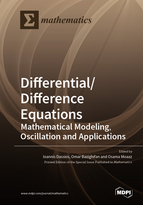Differential/Difference Equations: Mathematical Modeling, Oscillation and Applications
A special issue of Mathematics (ISSN 2227-7390). This special issue belongs to the section "Difference and Differential Equations".
Deadline for manuscript submissions: closed (31 December 2020) | Viewed by 36798
Special Issue Editors
Interests: differential/difference equations; dynamical systems; modeling and stability analysis of electric power systems; mathematics of networks; fractional calculus; mathematical modeling (power systems, materials science, energy, macroeconomics, social media, etc.); optimization for the analysis of large-scale data sets; fluid mechanics; discrete calculus; Bayes control; e-learning
Special Issues, Collections and Topics in MDPI journals
2. Department of Mathematics, Faculty of Science, Hadhramout University, Hadhramout 50512, Yemen
Interests: qualitative theory; ordinary differential equations; functional differential equations; dynamical systems; mathematical modeling
Special Issues, Collections and Topics in MDPI journals
Interests: differental equations; numerical analysis; analysis; applied mathematics; nonlinear dynamics; mathematical modelling; mathematical analysis; stability
Special Issues, Collections and Topics in MDPI journals
Special Issue Information
Dear Colleagues,
The study of oscillatory phenomena is an important part of the theory of differential equations. Oscillations naturally occur in virtually every area of applied science including, e.g., mechanics, electrical, radio engineering, and vibrotechnics.
This Special Issue will accept high-quality papers with original research results in theoretical research, and recent progress in the study of applied problems in science and technology.
Dr. Ioannis Dassios
Dr. Omar Bazighifan
Dr. Osama Moaaz
Guest Editors
Manuscript Submission Information
Manuscripts should be submitted online at www.mdpi.com by registering and logging in to this website. Once you are registered, click here to go to the submission form. Manuscripts can be submitted until the deadline. All submissions that pass pre-check are peer-reviewed. Accepted papers will be published continuously in the journal (as soon as accepted) and will be listed together on the special issue website. Research articles, review articles as well as short communications are invited. For planned papers, a title and short abstract (about 100 words) can be sent to the Editorial Office for announcement on this website.
Submitted manuscripts should not have been published previously, nor be under consideration for publication elsewhere (except conference proceedings papers). All manuscripts are thoroughly refereed through a single-blind peer-review process. A guide for authors and other relevant information for submission of manuscripts is available on the Instructions for Authors page. Mathematics is an international peer-reviewed open access semimonthly journal published by MDPI.
Please visit the Instructions for Authors page before submitting a manuscript. The Article Processing Charge (APC) for publication in this open access journal is 2600 CHF (Swiss Francs). Submitted papers should be well formatted and use good English. Authors may use MDPI's English editing service prior to publication or during author revisions.
Keywords
- Oscillation theory
- Differential/difference equations
- Partial differential equations
- Dynamical systems
- Fractional calculus
- Delays
- Mathematical modeling and oscillations








